Impact of Intraoperative Factors on the Development of Postpartum Septic Complications
Abstract
1. Introduction
2. Materials and Methods
2.1. Design of the Research and Population
2.2. Interpretation of Results
2.3. Methods of Statistical Analysis
3. Results
4. Discussion
5. Conclusions
Author Contributions
Funding
Institutional Review Board Statement
Informed Consent Statement
Data Availability Statement
Acknowledgments
Conflicts of Interest
References
- Tuuli, M.G.; Stout, M.J.; Martin, S.; Rampersad, R.M.; Cahill, A.G.; Macones, G.A. Comparison of Suture Materials for Subcuticular Skin Closure at Cesarean Delivery. Am. J. Obstet. Gynecol. 2016, 215, 490.e1–490.e5. [Google Scholar] [CrossRef] [PubMed]
- Poggi, S.B.H. Postpartum Hemorrhage & Abnormal Puerperium. In CURRENT Diagnosis & Treatment: Obstetrics & Gynecology, 12th ed.; DeCherney, A.H., Nathan, L., Laufer, N., Roman, A.S., Eds.; McGraw-Hill Education: New York, NY, USA, 2019. [Google Scholar]
- Kawakita, T.; Landy, H.J. Surgical Site Infections after Cesarean Delivery: Epidemiology, Prevention and Treatment. Matern. Health Neonatol. Perinatol. 2017, 3, 12. [Google Scholar] [CrossRef]
- Taylor, M.; Pillarisetty, L.S. Endometritis. Br. Med. J. 2022, 1, 818–821. [Google Scholar] [CrossRef]
- Karsnitz, D.B. Puerperal Infections of the Genital Tract: A Clinical Review. J. Midwifery Womens Health 2013, 58, 632–642. [Google Scholar] [CrossRef]
- El-Achi, V.; Wan, K.M.; Brown, J.; Marshall, D.; McGee, T. Readmissions for Surgical Site Infections Following Caesarean Section. Aust. N. Z. J. Obstet. Gynaecol. 2018, 58, 582–585. [Google Scholar] [CrossRef] [PubMed]
- Ahmed, I.; Boulton, A.J.; Rizvi, S.; Carlos, W.; Dickenson, E.; Smith, N.A.; Reed, M. The Use of Triclosan-Coated Sutures to Prevent Surgical Site Infections: A Systematic Review and Meta-Analysis of the Literature. BMJ Open 2019, 9, e029727. [Google Scholar] [CrossRef]
- Leaper, D.; Wilson, P.; Assadian, O.; Edmiston, C.; Kiernan, M.; Miller, A.; Bond-Smith, G.; Yap, J. The Role of Antimicrobial Sutures in Preventing Surgical Site Infection. Ann. R. Coll. Surg. Engl. 2017, 99, 439–443. [Google Scholar] [CrossRef]
- Kathju, S.; Nistico, L.; Hall-Stoodley, L.; Post, J.C.; Ehrlich, G.D.; Stoodley, P. Chronic Surgical Site Infection Due to Suture-Associated Polymicrobial Biofilm. Surg. Infect. (Larchmt.) 2009, 10, 457–461. [Google Scholar] [CrossRef]
- Dosedla, E.; Richnavský, J.; Turcsányiová, Z.; Ballová, Z.; Calda, P.; Dosedla, M.E. Actual Gynecology and Obstetrics the Application of Antibacterial Triclosan-Coated Poly-Glactin 910 Suture versus Conventional Polyglactin 910 Suture in Abdominal Hysterectomy: A Comparison of Selected Postoperative Complications. Actual Gyn. 2020, 12, 65–69. [Google Scholar]
- Marco, F.; Vallez, R.; Gonzalez, P.; Ortega, L.; de La Lama, J.; Lopez-Duran, L. Study of the Efficacy of Coated Vicryl plus Antibacterial Suture in an Animal Model of Orthopedic Surgery. Surg. Infect. (Larchmt.) 2007, 8, 359–365. [Google Scholar] [CrossRef]
- Ruiz-Tovar, J.; Alonso, N.; Ochagavía, A.; Arroyo, A.; Llavero, C. Effect of the Abdominal Fascial Closure with Triclosan-Coated Sutures in Fecal Peritonitis, on Surgical Site Infection, and Evisceration: A Retrospective Multi-Center Study. Surg. Infect. (Larchmt.) 2018, 19, 61–64. [Google Scholar] [CrossRef] [PubMed]
- Ademuyiwa, A.O.; Hardy, P.; Runigamugabo, E.; Sodonougbo, P.; Behanzin, H.; Kangni, S.; Agboton, G.; Adagrah, L.A.; Adjei-Acquah, E.; Acquah, A.O.; et al. Reducing Surgical Site Infections in Low-Income and Middle-Income Countries (FALCON): A Pragmatic, Multicentre, Stratified, Randomised Controlled Trial. Lancet 2021, 398, 1687–1699. [Google Scholar] [CrossRef]
- World Health Organisation Global Guidelines for the Prevention of Surgical Site Infection. Geneva: World Health Organization. 2018. Available online: https://apps.who.int/iris/bitstream/handle/10665/277399/9789241550475-eng.pdf (accessed on 14 April 2022).
- Olsen, M.A.; Butler, A.M.; Willers, D.M.; Gross, G.A.; Devkota, P.; Fraser, V.J. Risk Factors for Endometritis after Low Transverse Cesarean Delivery. Infect. Control. Hosp. Epidemiol. 2010, 31, 69–77. [Google Scholar] [CrossRef] [PubMed][Green Version]
- Molla, M.; Temesgen, K.; Seyoum, T.; Melkamu, M. Surgical Site Infection and Associated Factors among Women Underwent Cesarean Delivery in Debretabor General Hospital, Northwest Ethiopia: Hospital Based Cross-Sectional Study. BMC Pregnancy Childbirth 2019, 19, 317. [Google Scholar] [CrossRef] [PubMed]
- Kvalvik, S.A.; Rasmussen, S.; Thornhill, H.F.; Baghestan, E. Risk Factors for Surgical Site Infection Following Cesarean Delivery: A Hospital-Based Case–Control Study. Acta Obstet. Gynecol. Scand 2021, 100, 2167–2175. [Google Scholar] [CrossRef]
- Hamdy, M.A.; Taha, O.T.; Elprince, M. Postpartum Endometritis after Uterine Cleaning versus No Cleaning in Cesarean Sections: Randomized Clinical Trial. J. Obstet. Gynaec. Res. 2021, 47, 1330–1336. [Google Scholar] [CrossRef]
- Anorlu, R.I.; Maholwana, B.; Hofmeyr, G.J. Methods of Delivering the Placenta at Caesarean Section. In Cochrane Database of Systematic Reviews; John Wiley & Sons, Ltd.: Hoboken, NJ, USA, 2008. [Google Scholar] [CrossRef]
- Yu, D.; Wong, Y.M.; Cheong, Y.; Xia, E.; Li, T.C. Asherman Syndrome-One Century Later. Fertil. Steril. 2008, 89, 759–779. [Google Scholar] [CrossRef]
- Berlit, S.; Nickol, J.; Weiss, C.; Tuschy, B.; Mayer, J.; Suetterlin, M.; Kehl, S. Cervical Dilatation and Curettage in Elective Caesarean Section. A Retrospective Analysis. In Vivo (Brooklyn) 2013, 27, 661–665. [Google Scholar]
- Dahlke, J.D.; Mendez-Figueroa, H.; Maggio, L.; Sperling, J.D.; Chauhan, S.P.; Rouse, D.J. The Case for Standardizing Cesarean Delivery Technique: Seeing the Forest for the Trees. Obstet. Gynecol. 2020, 136, 972–980. [Google Scholar] [CrossRef]
- Bamigboye, A.A.; Hofmeyr, G.J. Closure versus non-closure of the peritoneum at caesarean section: Short- and long-term outcomes. In Cochrane Database of Systematic Reviews; John Wiley & Sons, Ltd.: Hoboken, NJ, USA, 2014. [Google Scholar] [CrossRef]
- Caesarean Section Surgical Techniques: 3 Year Follow-up of the CORONIS Fractional, Factorial, Unmasked, Randomised Controlled Trial. Lancet 2016, 388, 62–72. [CrossRef]
- Kurek Eken, M.; Özkaya, E.; Tarhan, T.; İçöz, Ş.; Eroğlu, Ş.; Kahraman, T.; Karateke, A. Effects of Closure versus Non-Closure of the Visceral and Parietal Peritoneum at Cesarean Section: Does It Have Any Effect on Postoperative Vital Signs? A Prospective Randomized Study. J. Matern. Fetal Neonatal Med. 2017, 30, 922–926. [Google Scholar] [CrossRef]
- Atabekoǧlu, C.S.; Türkçüoǧlu, I.; Duru, B.; Sönmezer, M.; Süer, G.; Uysalel, A.; Koç, A.; Söylemez, F. Closure vs Non-Closure of Peritoneum at Caesarean Section: Evaluation of Pain. J. Obstet. Gynaecol. 2011, 31, 307–310. [Google Scholar] [CrossRef]
- Omran, E.F.; Meshaal, H.; Hassan, S.M.; Dieb, A.S.; Nabil, H.; Saad, H. The Effect of Rectus Muscle Re-Approximation at Cesarean Delivery on Pain Perceived after Operation: A Randomized Control Trial. J. Matern. Fetal Neonatal Med. 2019, 32, 3238–3243. [Google Scholar] [CrossRef] [PubMed]
- Dahlke, J.D.; Mendez-Figueroa, H.; Rouse, D.J.; Berghella, V.; Baxter, J.K.; Chauhan, S.P. Evidence-Based Surgery for Cesarean Delivery: An Updated Systematic Review. Am. J. Obstet. Gynecol. 2013, 209, 294–306. [Google Scholar] [CrossRef] [PubMed]
- Gomaa, K.; Abdelraheim, A.R.; el Gelany, S.; Khalifa, E.M.; Yousef, A.M.; Hassan, H. Incidence, Risk Factors and Management of Post Cesarean Section Surgical Site Infection (SSI) in a Tertiary Hospital in Egypt: A Five Year Retrospective Study. BMC Pregnancy Childbirth 2021, 21, 634. [Google Scholar] [CrossRef]
- Ousey, K.; Blackburn, J.; Stephenson, J.; Southern, T. Incidence and Risk Factors for Surgical Site Infection Following Emergency Cesarean Section: A Retrospective Case-Control Study. Adv. Skin Wound Care 2021, 34, 482–487. [Google Scholar] [CrossRef] [PubMed]
- Felder, L.; Paternostro, A.; Quist-Nelson, J.; Baxter, J.; Berghella, V. Implementation of Vaginal Cleansing Before Cesarean Delivery to Decrease Endometritis Rates. J. Matern. Fetal Neonatal Med. 2019, 32, 1997–2002. [Google Scholar] [CrossRef]
- Tita, A.T.N.; Szychowski, J.M.; Boggess, K.; Saade, G.; Longo, S.; Clark, E.; Esplin, S.; Cleary, K.; Wapner, R.; Letson, K.; et al. Adjunctive Azithromycin Prophylaxis for Cesarean Delivery. N. Engl. J. Med. 2016, 375, 1231–1241. [Google Scholar] [CrossRef]
- Dieplinger, B.; Egger, M.; Jezek, C.; Heinisch-Finke, C.; Altendorfer, C.; Pernerstorfer, T.; Hefler, L.; Pateisky, N.; Mueller, T. Implementation of a Comprehensive Unit-Based Safety Program to Reduce Surgical Site Infections in Cesarean Delivery. Am. J. Infect. Control 2020, 48, 386–390. [Google Scholar] [CrossRef]
- Salim, R.; Braverman, M.; Teitler, N.; Berkovic, I.; Suliman, A.; Shalev, E. Risk Factors for Infection Following Cesarean Delivery: An Interventional Study. J. Matern. Fetal Neonatal Med. 2012, 25, 2708–2712. [Google Scholar] [CrossRef] [PubMed]
- Getaneh, T.; Negesse, A.; Dessie, G. Prevalence of Surgical Site Infection and Its Associated Factors after Cesarean Section in Ethiopia: Systematic Review and Meta-Analysis. BMC Pregnancy Childbirth 2020, 20, 311. [Google Scholar] [CrossRef]
- Gupta, S.; Manchanda, V.; Sachdev, P.; Kumar Saini, R.; Joy, M. Study of Incidence and Risk Factors of Surgical Site Infections in Lower Segment Caesarean Section Cases of Tertiary Care Hospital of North India. Indian J. Med. Microbiol. 2021, 39, 1–5. [Google Scholar] [CrossRef]
- Coleman, J.; Murtha, A.; Silverman, N.S. ACOG Practice Bulletin No. 199: Use of Prophylactic Antibiotics in Labor and Delivery. Obstet. Gynecol. 2018, 132, E103–E119. [Google Scholar] [CrossRef]
- Berghella, V. Cesarean Birth: Preoperative Planning and Patient Preparation—UpToDate. Available online: https://www.uptodate.com/contents/cesarean-birth-preoperative-planning-and-patient-preparation?search=cesarean%20section&source=search_result&selectedTitle=3~150&usage_type=default&display_rank=3 (accessed on 14 July 2022).
- Wang, S.S.; Shum, D.; Kennedy, A. Imaging of Postpartum/Peripartum Complications. Radiol. Clin. N. Am. 2020, 58, 431–443. [Google Scholar] [CrossRef]
- Mulic-Lutvica, A.; Axelsson, O. Postpartum Ultrasound in Women with Postpartum Endometritis, after Cesarean Section and after Manual Evacuation of the Placenta. Acta Obstet. Gynecol. Scand. 2007, 86, 210–217. [Google Scholar] [CrossRef] [PubMed]
- Berral, A.; Pira, E.; Romano, C. Overdiagnosis and Defensive Medicine in Occupational Medicine. G. Ital. Med. Lav. Ergon. 2014, 36, 321–331. [Google Scholar] [PubMed]
- Kawakita, T.; Iqbal, S.N.; Landy, H.J.; Huang, J.C.; Fries, M. Reducing Cesarean Delivery Surgical Site Infections: A Resident-Driven Quality Initiative. Obstet. Gynecol. 2019, 133, 282–288. [Google Scholar] [CrossRef] [PubMed]
- Carter, E.B.; Temming, L.A.; Fowler, S.; Eppes, C.; Gross, G.; Srinivas, S.K.; Macones, G.A.; Colditz, G.A.; Tuuli, M.G. Evidence-Based Bundles and Cesarean Delivery Surgical Site Infections: A Systematic Review and Meta-Analysis. Obstet. Gynecol. 2017, 130, 735–746. [Google Scholar] [CrossRef]
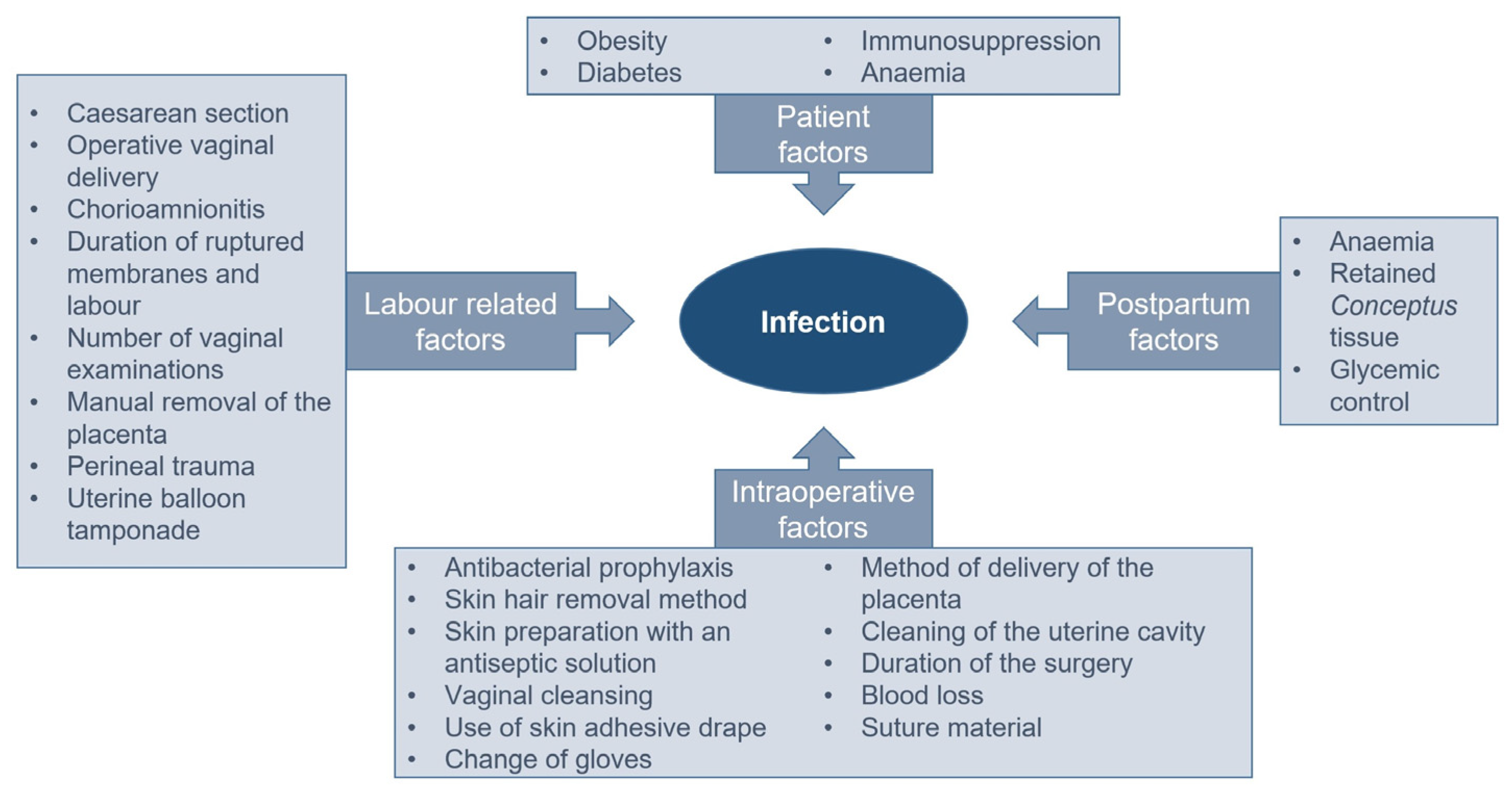
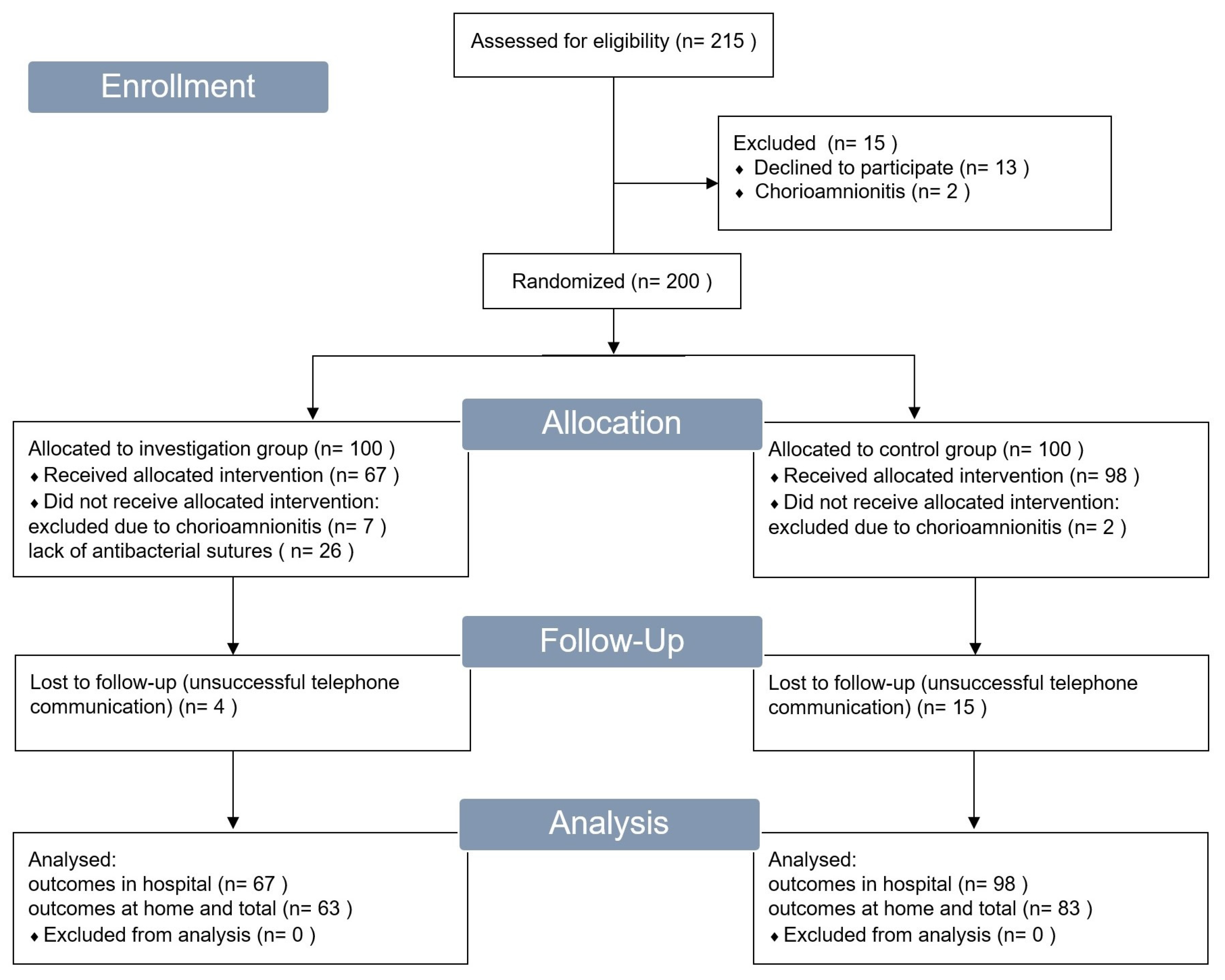
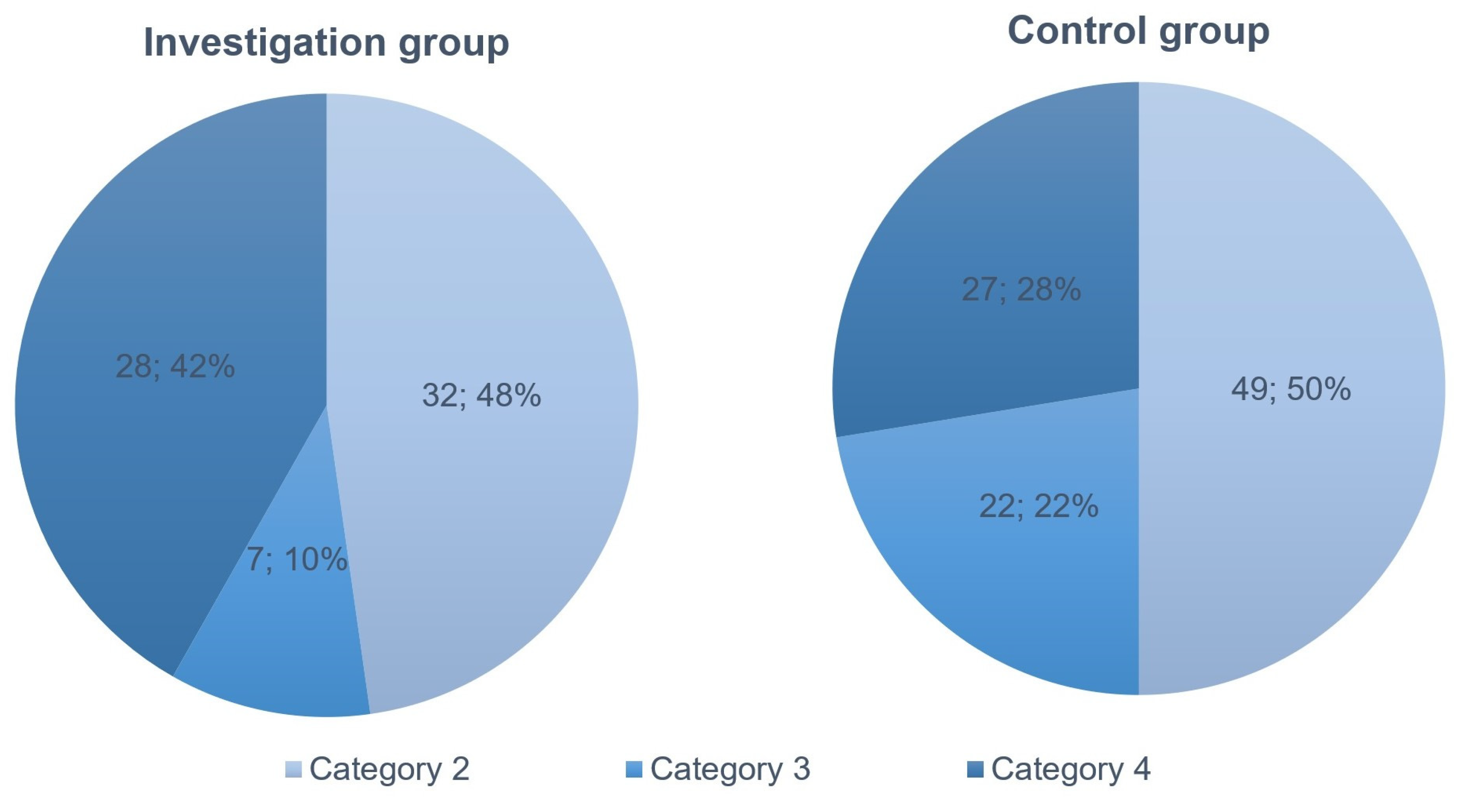
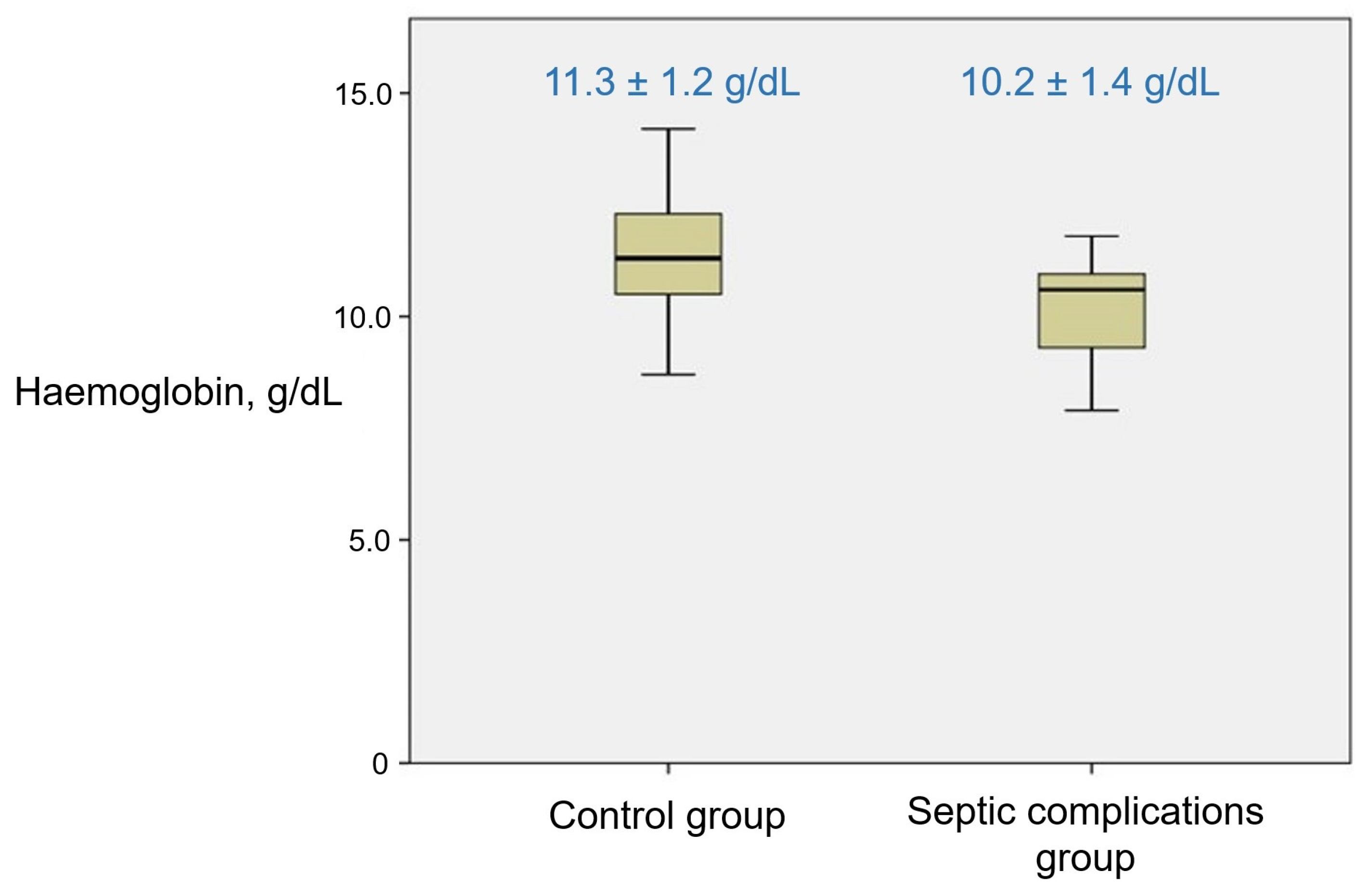

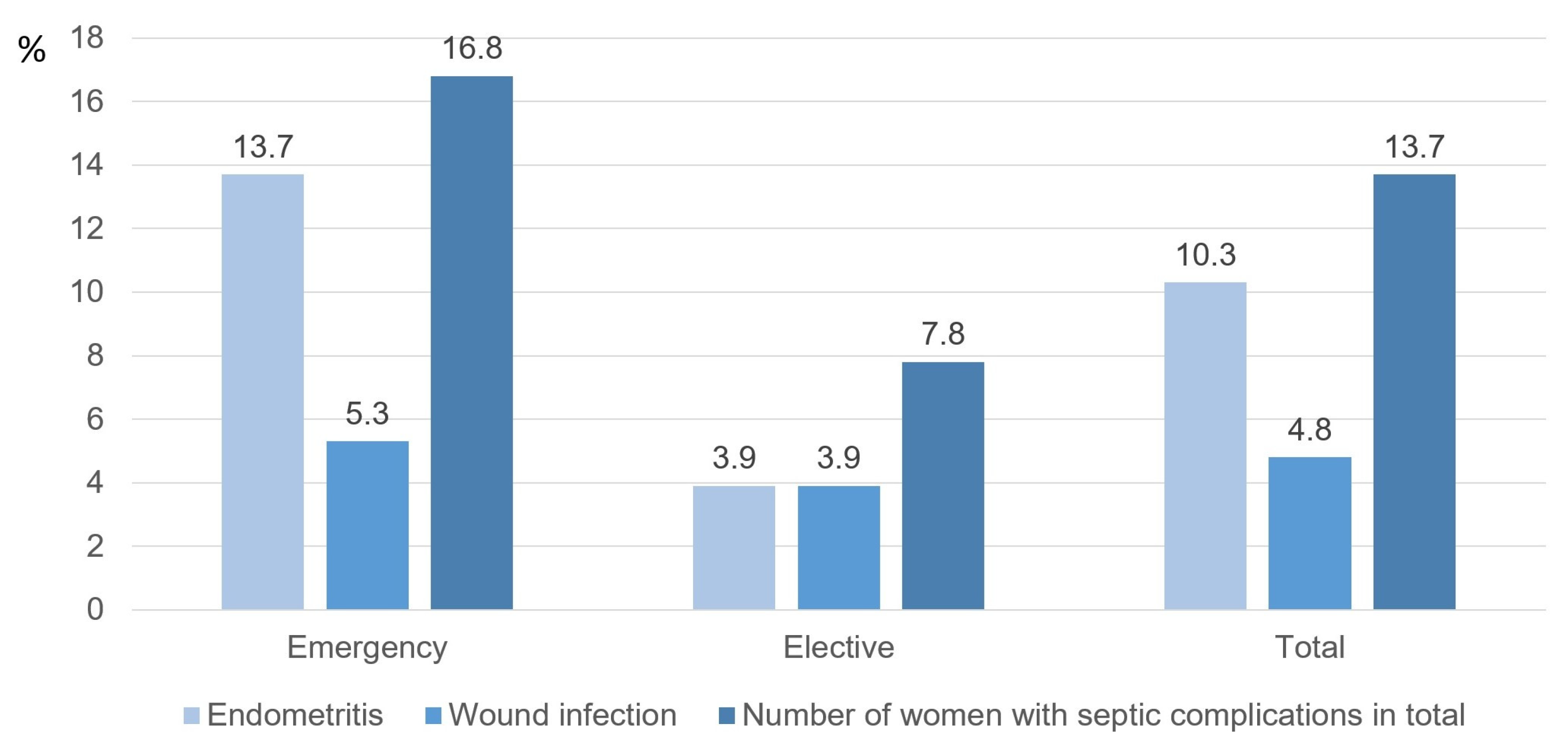
| Parameter | Investigation Group (n = 67), n (%) | Control Group (n = 98), n (%) | p-Value |
|---|---|---|---|
| Maternal age, years ± SD | 31.4 ± 5.4 | 32.7 ± 5.2 | 0.133 |
| BMI, kg/m2 | 25.5 ± 5.7 | 24.4 ± 5.2 | 0.205 |
| BMI ≥ 30 kg/m2 | 13 (19.4) | 16 (16.3) | 0.61 |
| Smoking | 2 (3) | 4 (4.1) | 1 |
| Gestational diabetes | 11 (16.4) | 14 (14.3) | 0.708 |
| Nulliparous | 36 (53.7) | 50 (51.0) | 0.732 |
| Multiparous | 31 (46.3) | 48 (49.0) | |
| Gestation age, weeks | 39.5 ± 2.0 | 39.7 ± 2.0 | 0.613 |
| Preterm delivery | 4 (6) | 5 (5.1) | 1 |
| Positive group B streptococcus | 13 (19.4) | 10 (10.2) | 0.235 |
| In-labour caesarean section | 32 (47.8) | 45 (45.9) | 0.816 |
| Caesarean section in the second stage of labour | 4 (6) | 9 (9.2) | 0.452 |
| Duration of labour ≥ 12 h | 9 (13.4) | 9 (9.2) | 0.403 |
| Rupture of membranes before caesarean section | 35 (52.2) | 59 (60.2) | 0.31 |
| Number of vaginal examinations | 2.9 ± 3.1 | 3.2 ± 3.1 | 0.59 |
| Vaginal exams ≥ 5 | 24 (35.8) | 31 (31.6) | 0.575 |
| Factor | Investigation Group (n = 67), n (%) | Control Group (n = 98), n (%) | p-Value |
|---|---|---|---|
| Operation time, minutes ± SD | 37.2 ± 10.7 | 36.2 ± 9.9 | 0.539 |
| Duration of caesarean section ≥ 1 h | 3 (4.5) | 2 (2) | 0.397 |
| Blood loss, mL | 579.9 ± 134.6 | 585.7 ± 149.4 | 0.797 |
| Blood loss ≥ 1000 mL | 4 (6) | 5 (5.1) | 1 |
| Closure of subcutaneous layer | 53 (79.1) | 60 (61.2) | 0.015 |
| Instrumental uterine cavity revision | 11 (16.4) | 12 (12.2) | 0.447 |
| Use of hemostatic sponge | 7 (10.4) | 13 (13.3) | 0.586 |
| Additional manipulations during caesarean section | 9 (13.4) | 8 (8.2) | 0.274 |
| Emergency caesarean section | 39 (58.2) | 71 (72.4) | 0.057 |
| Variable | Investigation Group (n = 67), n (%) | Control Group (n = 98), n (%) | p-Value |
|---|---|---|---|
| CRP, mg/L ± SD | 64.4 ± 40.9 | 68.2 ± 39.1 | 0.544 |
| Leukocytes, 103/mm3 | 10.0 ± 2.8 | 9.3 ± 2.2 | 0.07 |
| Postoperative haemoglobin, g/dL | 11.3 ± 1.2 | 11.1 ± 1.3 | 0.323 |
| Postoperative haemoglobin < 10.5 g/dL | 15 (22.4) | 34 (34.7) | 0.089 |
| Postpartum ultrasound | 30 (44.8) | 42 (42.9) | 0.807 |
| VAS score on 1st postoperative day | 5.9 ± 1.9 | 5.9 ± 2.2 | 0.968 |
| VAS score ≥ 5 on 1st postoperative day | 47 (70.1) | 63 (64.3) | 0.433 |
| VAS score on the 4th postoperative day | 3.6 ± 1.4 | 3.4 ± 1.6 | 0.325 |
| VAS score ≥ 5 on the 4th postoperative day | 18 (26.9) | 18 (18.4) | 0.194 |
| Duration of hospitalization after caesarean section, days | 4.9 ± 2.1 | 4.7 ± 1.5 | 0.47 |
| At home | n = 63 | n = 83 | - |
| VAS score | 2.6 ± 2 | 2.7 ± 1.6 | 0.951 |
| VAS score ≥ 5 | 11 (17.5) | 11 (13.3) | 0.482 |
| Use of painkillers | 19 (30.2) | 24 (28.9) | 0.87 |
| Outcomes | Investigation Group (n = 67), n (%) | Control Group (n = 98), n (%) | p-Value |
|---|---|---|---|
| In hospital | n = 67 | n = 98 | - |
| Endometritis | 7 (10.4) | 7 (7.1) | 0.454 |
| Wound infection | 1 (1.5) | 1 (1) | 1 |
| All septic complications | 8 (11.9) | 8 (8.2) | 0.421 |
| At home | n = 63 | n = 83 | - |
| Endometritis | 3 (4.9) | 0 (0) | 0.08 |
| Wound infection | 3 (4.9) | 2 (2.5) | 0.451 |
| Contacting a healthcare institution | 8 (13.3) | 6 (7.6) | 0.266 |
| Readmission | 1 (1.6) | 2 (2.5) | 1 |
| Total | n = 63 | n = 83 | - |
| Endometritis | 8 (11.7) | 7 (8.4) | 0.401 |
| Wound infection | 4 (6.3) | 3 (3.6) | 0.444 |
| Number of women with septic complications | 10 (15.9) | 10 (12) | 0.506 |
| Factor | Endometritis in the Factor Group, n (%) | Endometritis in the Control Group, n (%) | p-Value |
|---|---|---|---|
| Duration of caesarean section ≥ 1 h, n = 5 | 2 (40) | 13 (9.2) | 0.082 |
| Blood loss ≥ 1000 mL, n = 9 | 1 (11.1) | 14 (10.2) | 1 |
| Instrumental uterine cavity revision, n = 21 | 5 (23.8) | 10 (8) | 0.043 |
| Use of hemostatic sponge, n = 16 | 3 (18.8) | 12 (9.2) | 0.215 |
| Additional manipulations during caesarean section, n = 12 | 1 (8.3) | 12 (10.5) | 1 |
| Suturing of the visceral peritoneum, n = 11 | 0 (0) | 15 (11.1) | 0.605 |
| Suturing of the parietal peritoneum, n = 20 | 1 (5) | 14 (11.1) | 0.694 |
| Suturing of the rectus abdominis muscle, n = 6 | 0 (0) | 15 (10.7) | 1 |
| Closure of subcutaneous layer, n = 100 | 12 (12) | 3 (6.5) | 0.39 |
Disclaimer/Publisher’s Note: The statements, opinions and data contained in all publications are solely those of the individual author(s) and contributor(s) and not of MDPI and/or the editor(s). MDPI and/or the editor(s) disclaim responsibility for any injury to people or property resulting from any ideas, methods, instructions or products referred to in the content. |
© 2023 by the authors. Licensee MDPI, Basel, Switzerland. This article is an open access article distributed under the terms and conditions of the Creative Commons Attribution (CC BY) license (https://creativecommons.org/licenses/by/4.0/).
Share and Cite
Andzane, D.; Miskova, A.; Krone, A.; Rezeberga, D. Impact of Intraoperative Factors on the Development of Postpartum Septic Complications. Medicina 2023, 59, 1637. https://doi.org/10.3390/medicina59091637
Andzane D, Miskova A, Krone A, Rezeberga D. Impact of Intraoperative Factors on the Development of Postpartum Septic Complications. Medicina. 2023; 59(9):1637. https://doi.org/10.3390/medicina59091637
Chicago/Turabian StyleAndzane, Diana, Anna Miskova, Antra Krone, and Dace Rezeberga. 2023. "Impact of Intraoperative Factors on the Development of Postpartum Septic Complications" Medicina 59, no. 9: 1637. https://doi.org/10.3390/medicina59091637
APA StyleAndzane, D., Miskova, A., Krone, A., & Rezeberga, D. (2023). Impact of Intraoperative Factors on the Development of Postpartum Septic Complications. Medicina, 59(9), 1637. https://doi.org/10.3390/medicina59091637






